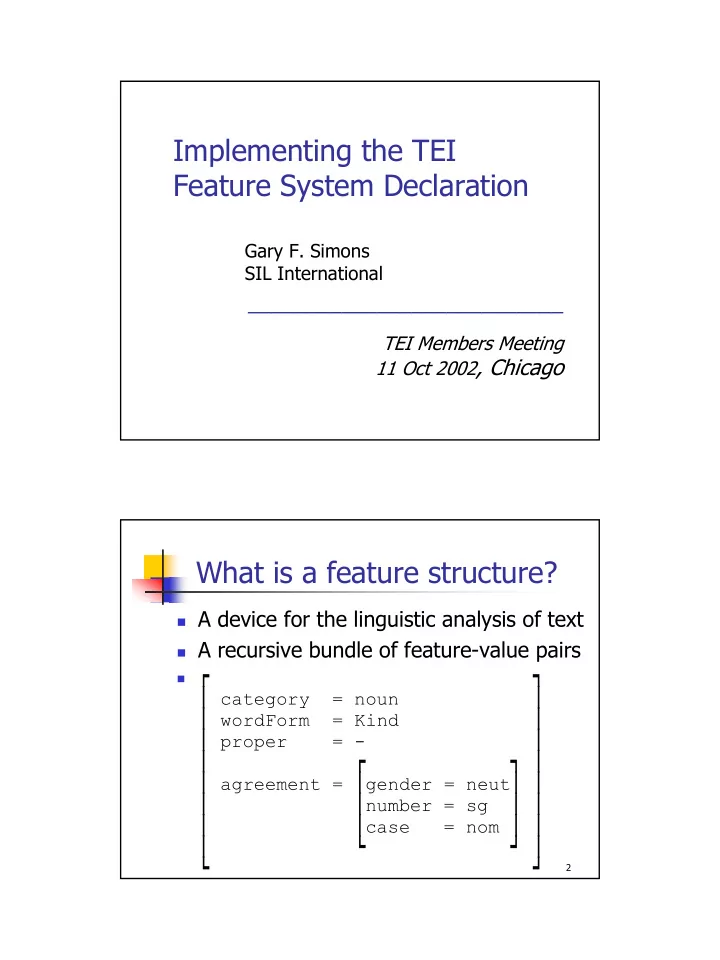

Implementing the TEI Feature System Declaration Gary F. Simons SIL International ___________________________ TEI Members Meeting 11 Oct 2002 , Chicago What is a feature structure? � A device for the linguistic analysis of text � A recursive bundle of feature-value pairs � ┍ ┑ │ category = noun │ │ wordForm = Kind │ │ proper = - │ │ ┍ ┑ │ │ agreement = │ gender = neut │ │ │ │ number = sg │ │ │ │ case = nom │ │ │ ┕ ┙ │ ┕ ┙ 2
In TEI markup � <fs> <f name="category"><sym value="noun"></f> <f name="wordForm"><str>Kind</str></f> <f name="proper"><minus/></f> <f name="agreement"> <fs><f name="gender"> <sym value="neut"></f> <f name="number"> <sym value="sg"></f> <f name="case"><sym value="nom"></f> </fs></f> </fs> 3 What is an FSD? � An auxiliary document type used in conjunction with <fs> markup to: � Document the allowed features � Document their allowed values � Specify default values for underspecified features � Specify constraints on feature co-occurrence � In short: “It’s an XML schema language for <fs> markup.” 4
An implementation strategy � Use XSLT scripts to generate XSLT scripts — inspired by Schematron � Compilation phase (applied to FSD) 1. Script-1 generates script-3 to add defaults 2. Script-2 generates script-4 to test validity � Execution phase (applied to document) 3. Script-3 adds default feature values 4. Script-4 generates an HTML report of violations 5 The tricky bit: subsumption � Default specifications and co-occurrence constraints are based on subsumption — a subsumption test translates to an XPath � E.g., an English pronoun has gender if and only if it is third person and singular � The current <fs> has gender: � test="current()[ f[@name= ' gender ' ] ]" � The current <fs> is third person singular: � test="current()[ f[@name='pers']/sym[@value='3rd'] ] [ f[@name='number']/sym[@value='sg'] ] " 6
Errors reported by validator � The feature structure type Type is not defined in the FSD. � A feature has no name. � The feature structure violates a constraint. � The feature named Name is not defined for the current fs type. � The value of the feature named Name is not in the value range defined for it in the FSD. � The feature named Name is not allowed to have more than one value. 7 Sample error report In /TEI.2/text/body/div[2]/fsLib/fs[3]: The feature structure violates a constraint. pronoun [ pron-type: personal pers: 3rd number: pl gender: feminine ] If the feature structure has: [ gender: any ], i t must also have: [ pers: 3rd; number: sg ]. 8
Toward an ISO standard? � It has been proposed that TEI feature structure markup be put forward to the new ISO TC37/SC4 as a proposed standard � TC 37 — “Terminology and other language resources” � SC 4 — “Language resources” � Chair: Laurent Romary 9 Some issues � Current DTDs for <fs> and FSD are intertwined with the TEI DTD: � An ISO standard would need to stand on its own. � Current scheme has bells and whistles that have never been implemented: � An ISO standard should be simplified and be backed by a working implementation. 10
Making it stand on its own � Drop TEI extension mechanisms in favor of fixed names and content models. � In the DTD for the FSD: � Drop dependency on TEI header in favor of a header with a content model of ANY. � Drop dependency on TEI %paraContent in favor of a documentation element with a content model of ANY. 11 Making it simpler � Drop most global attributes. � Drop <alt>; <fAlt> is adequate. � Drop value types motivated by general data representation (e.g. <nbr>, <msr>, <rate>) � Rethink special values in light of implemen- tation (e.g. <uncertain>, <dft>, <none>, <any>) � Rethink relation attribute in light of implementation (e.g. eq, ne, sb, ns) 12
Recommend
More recommend